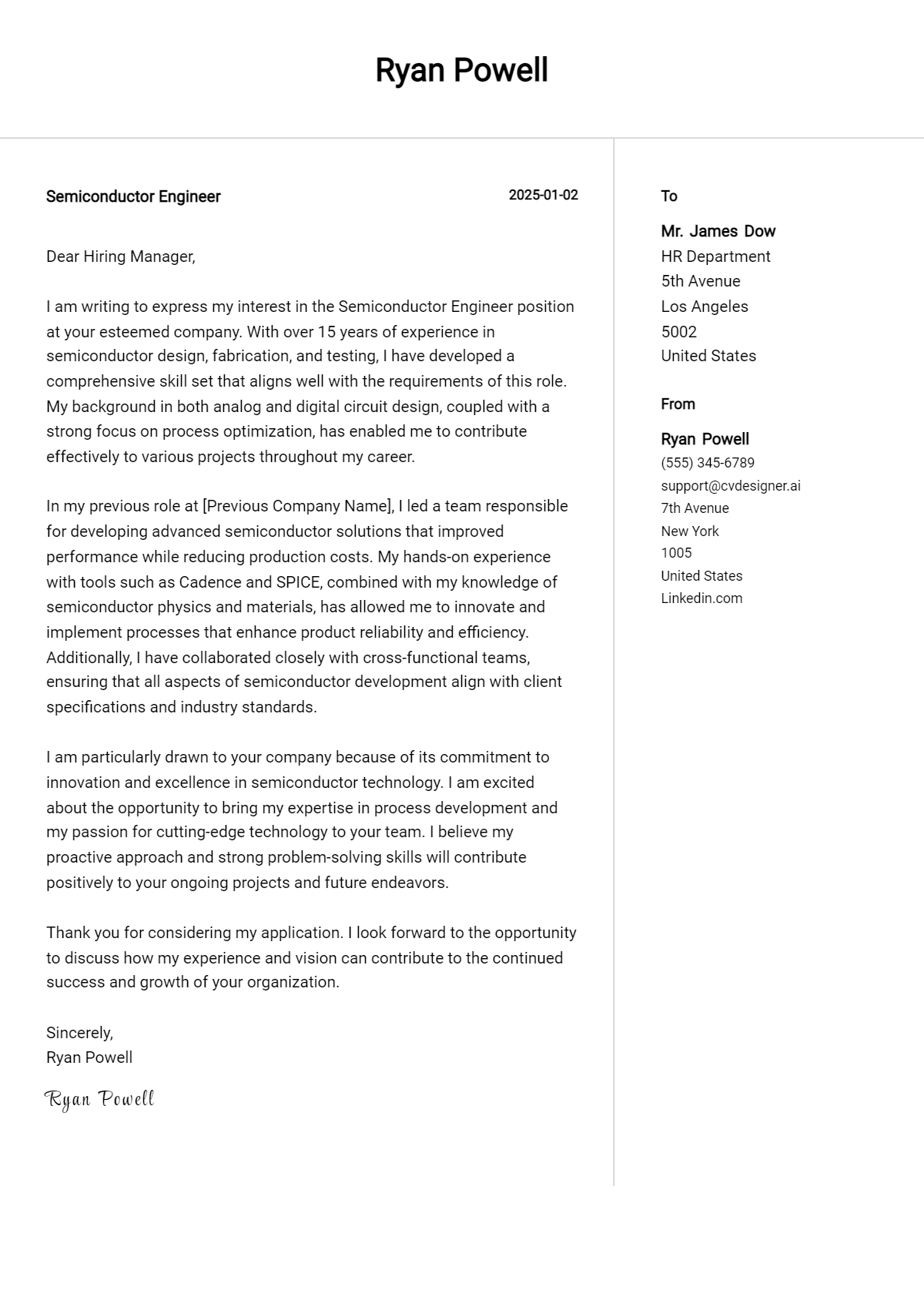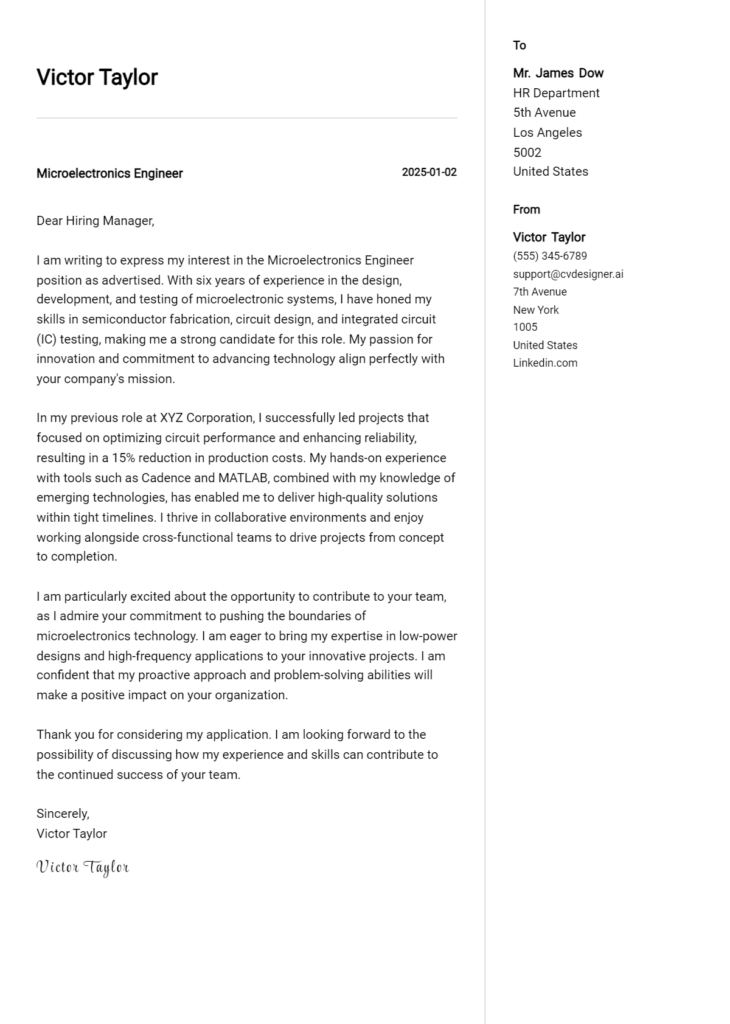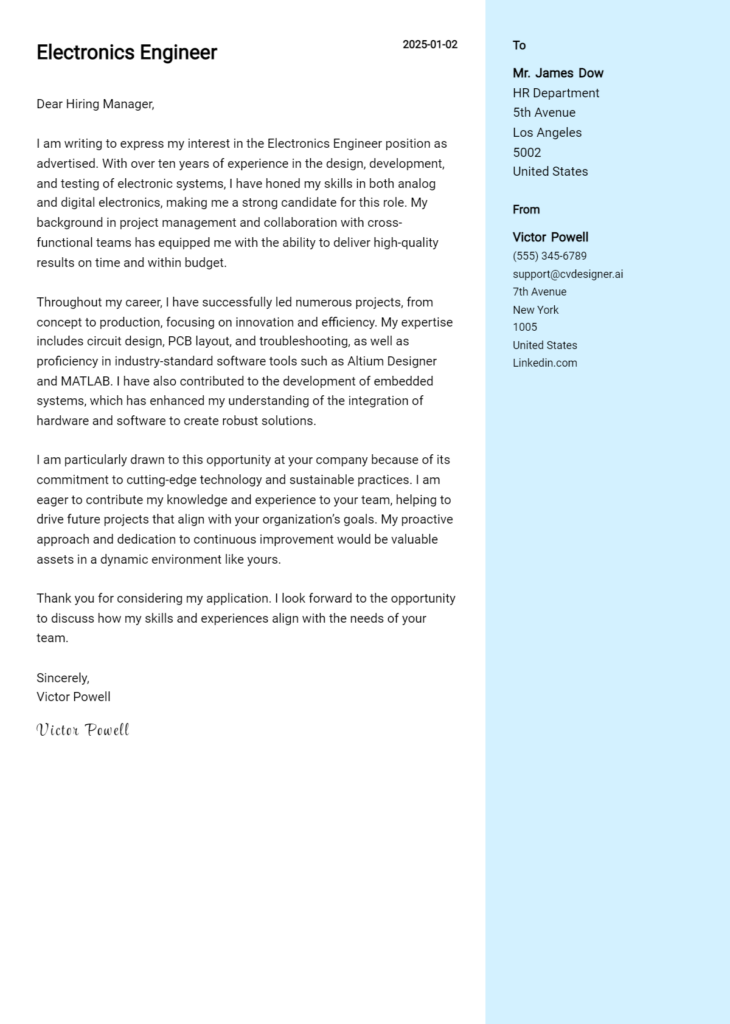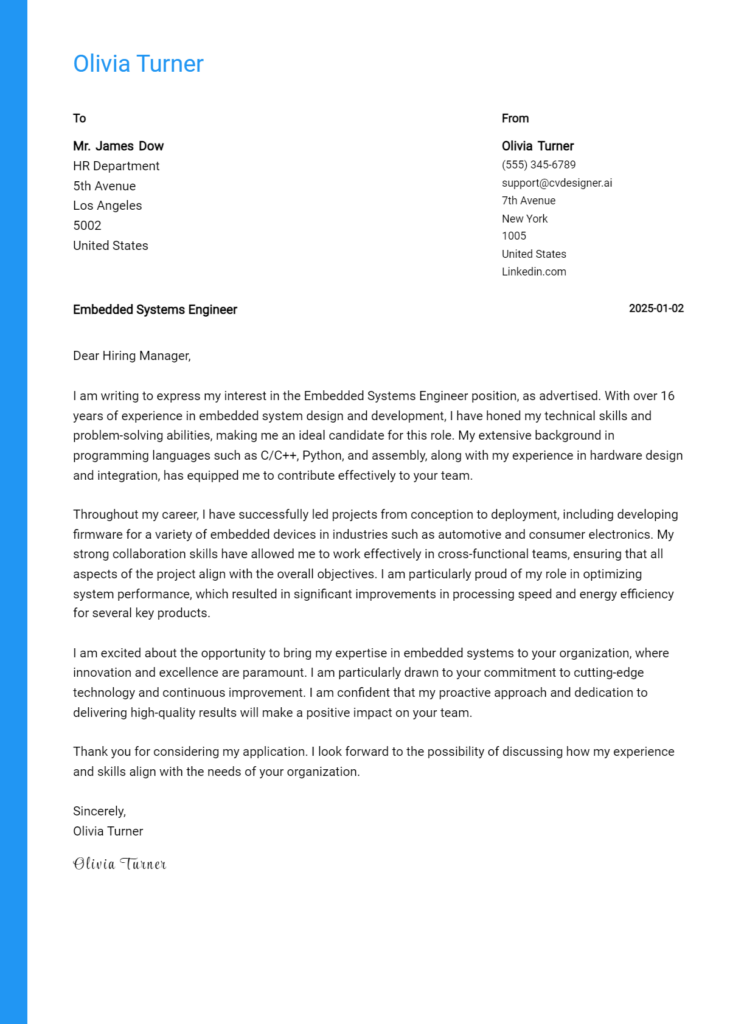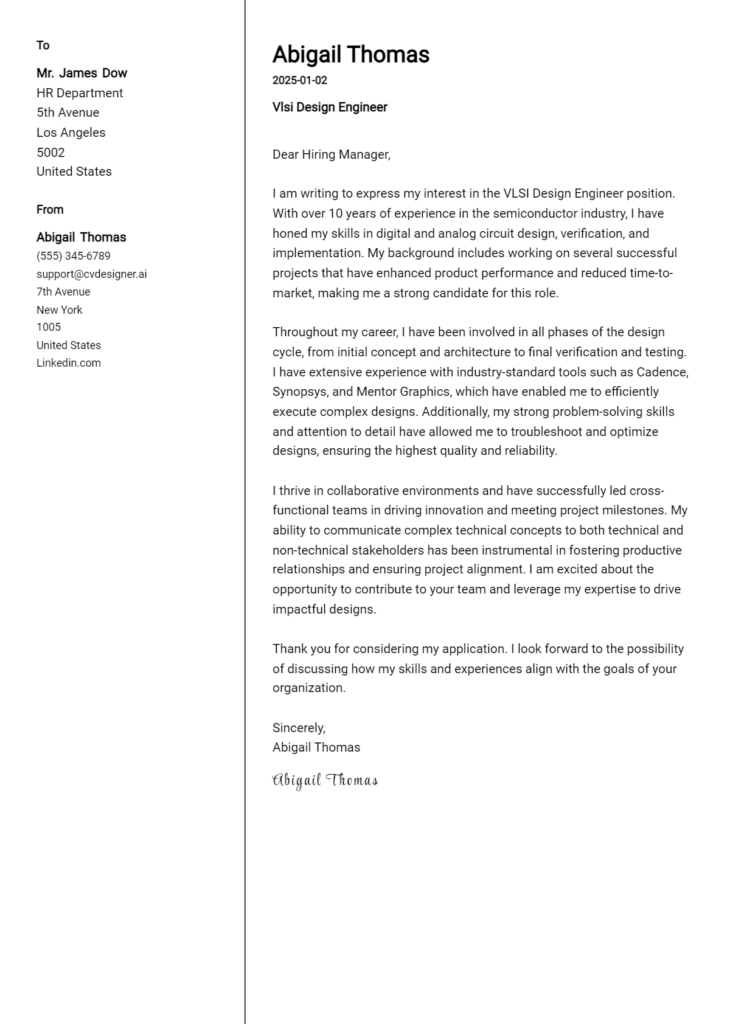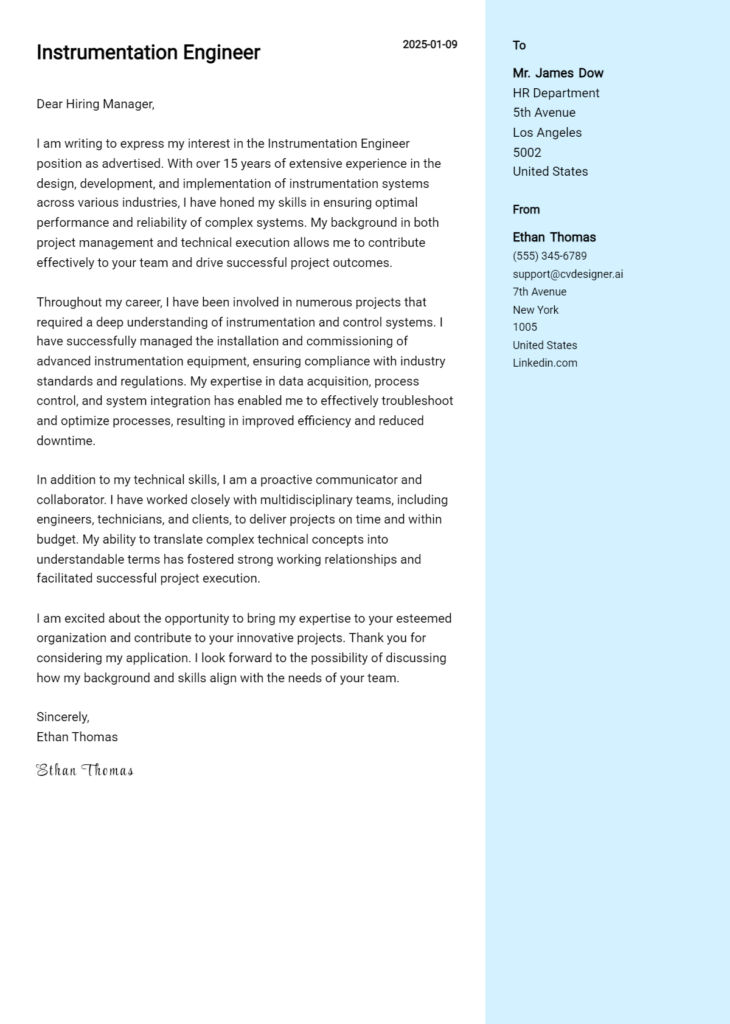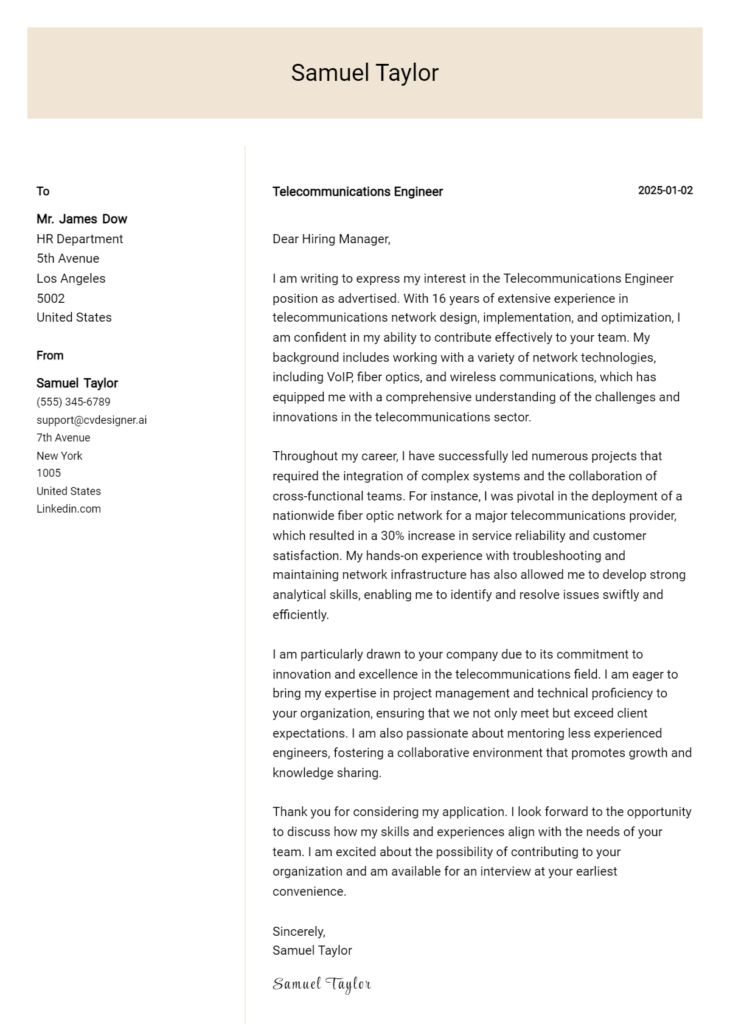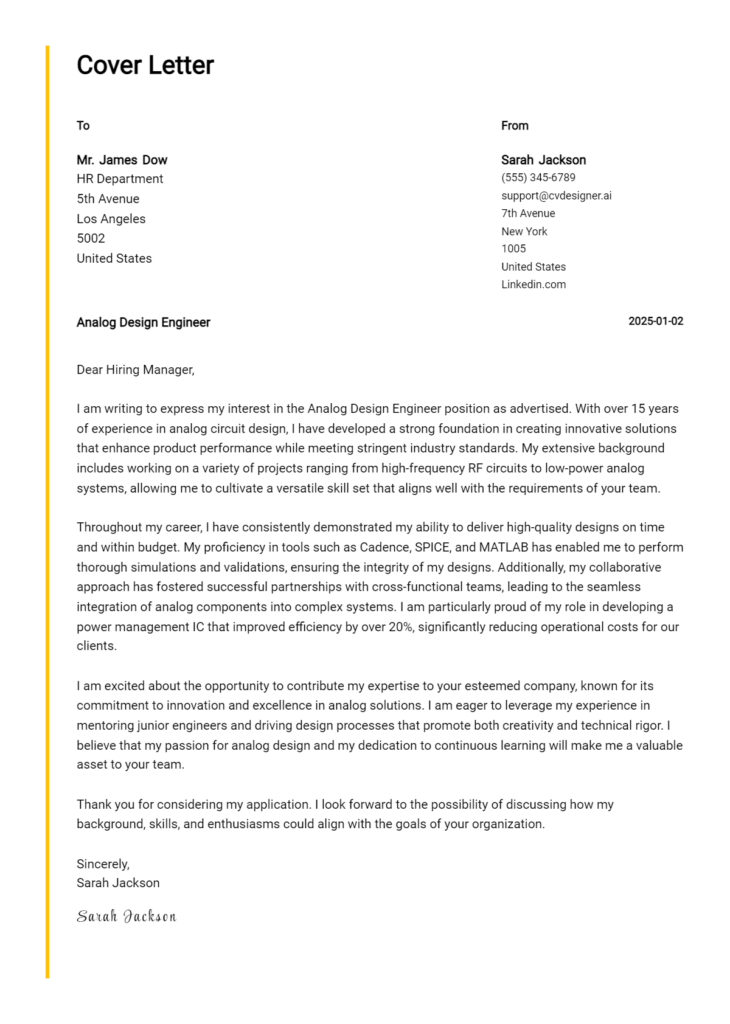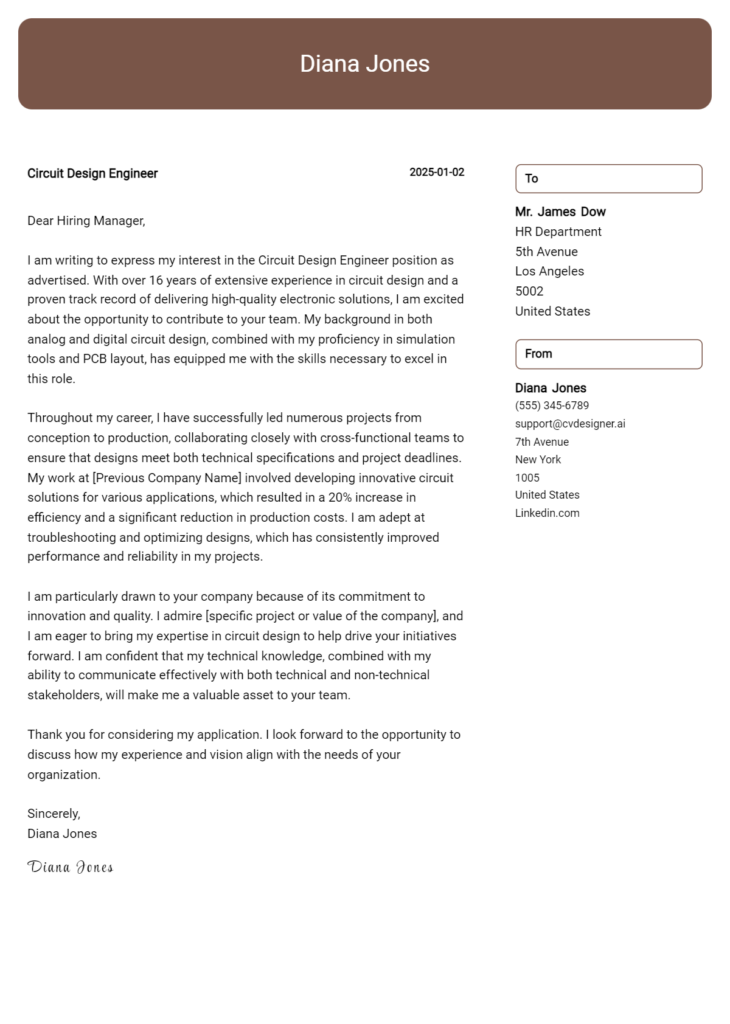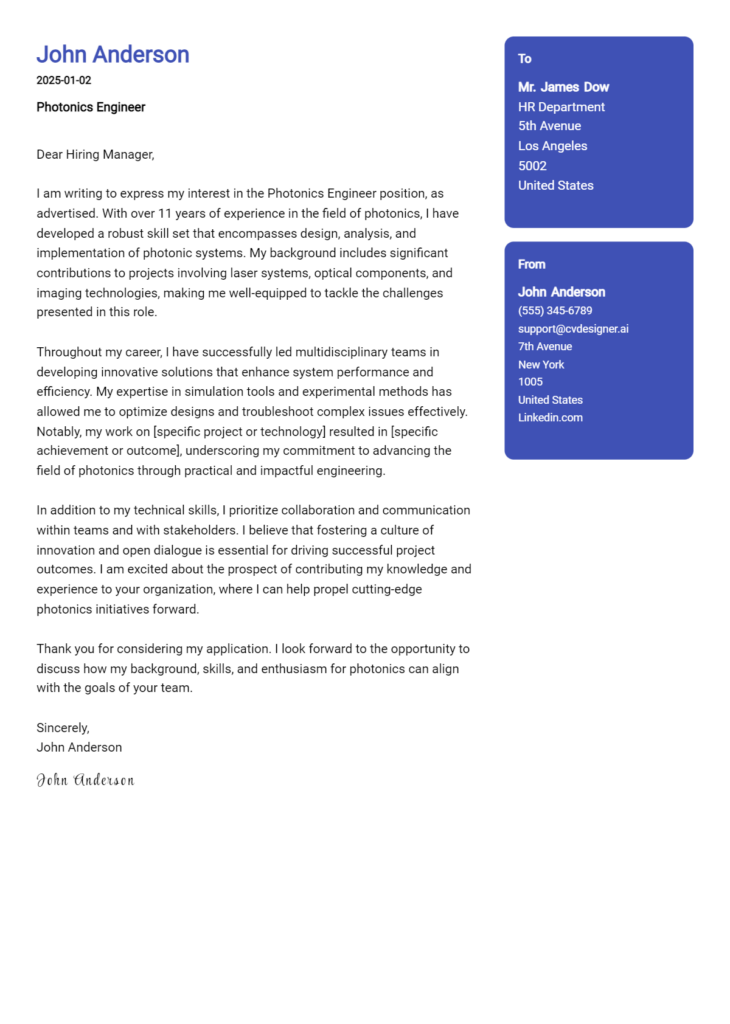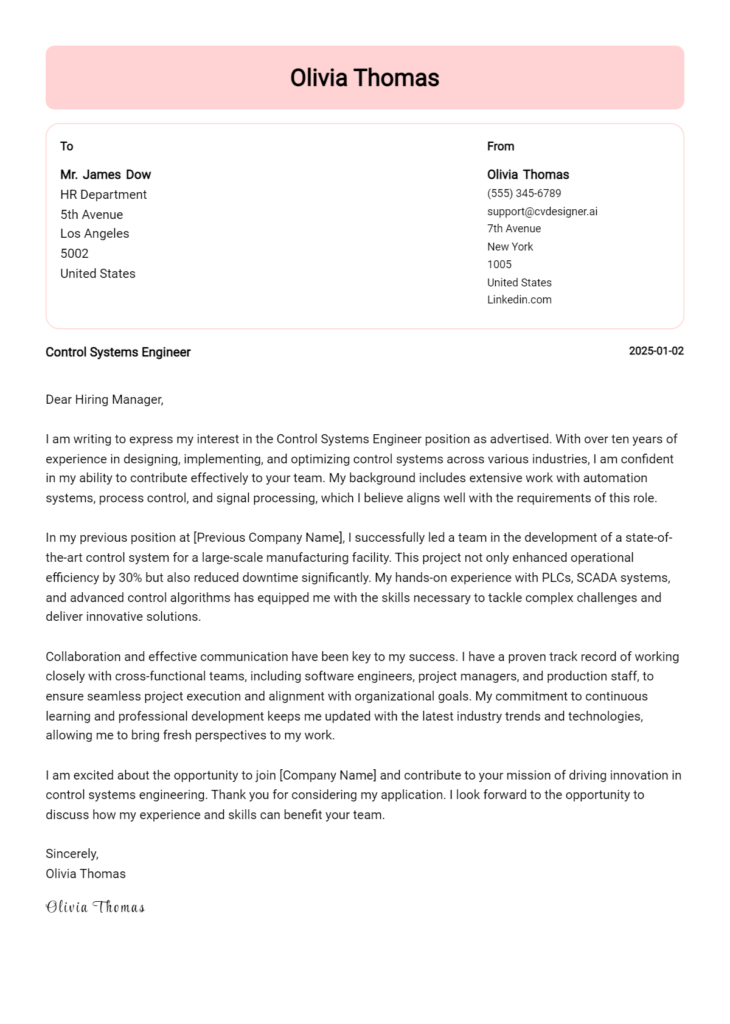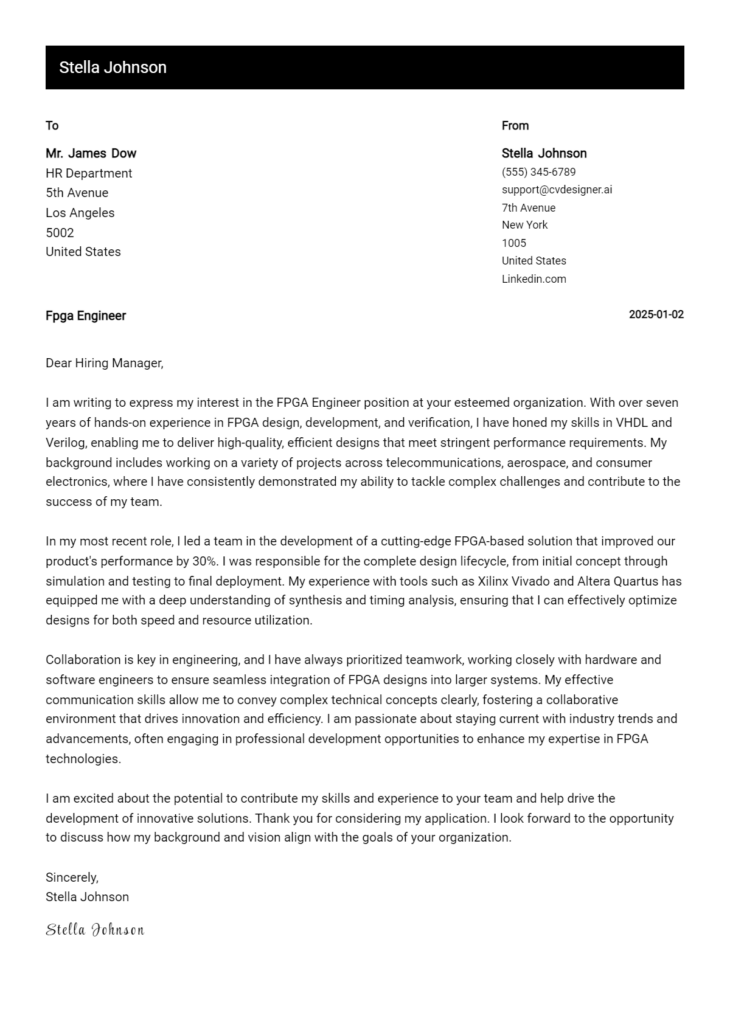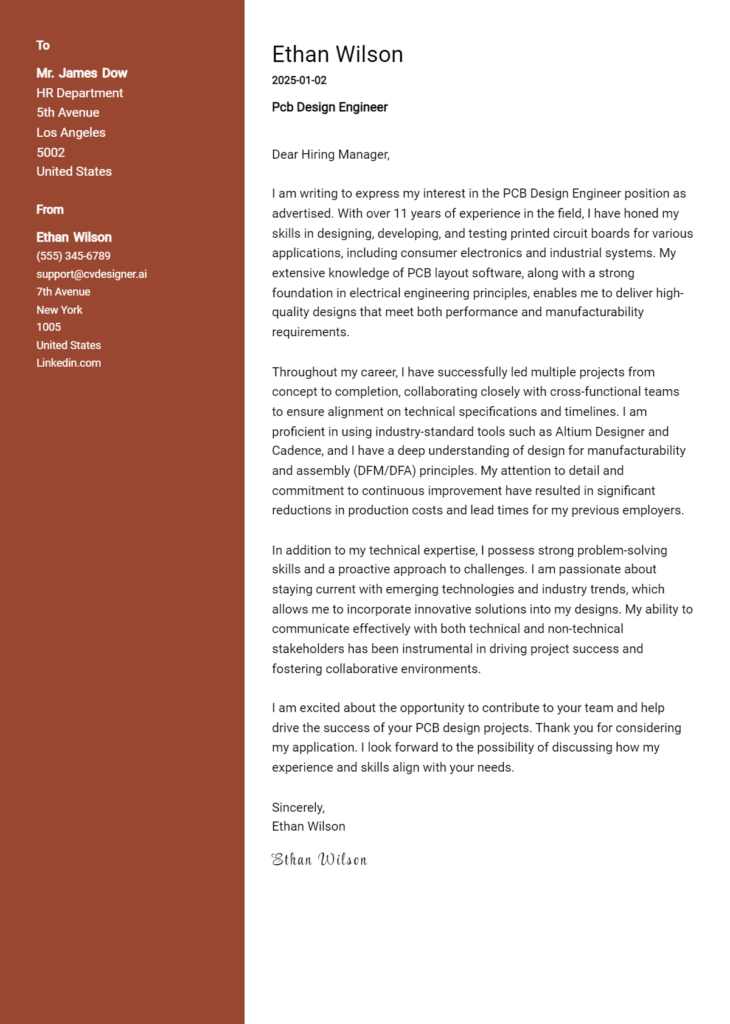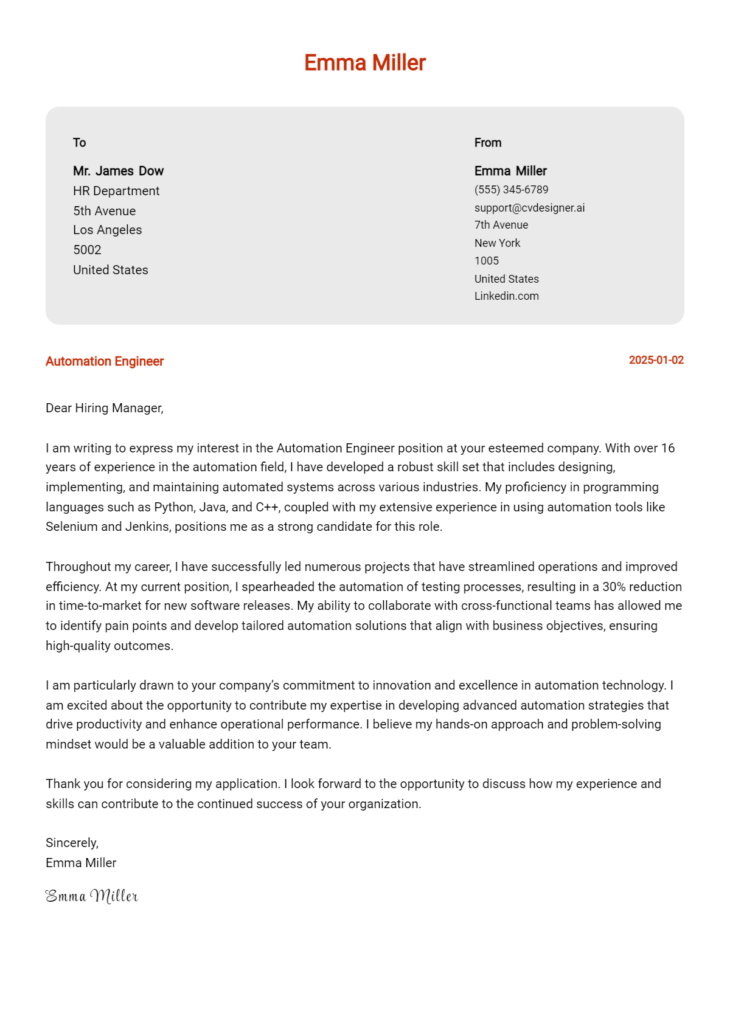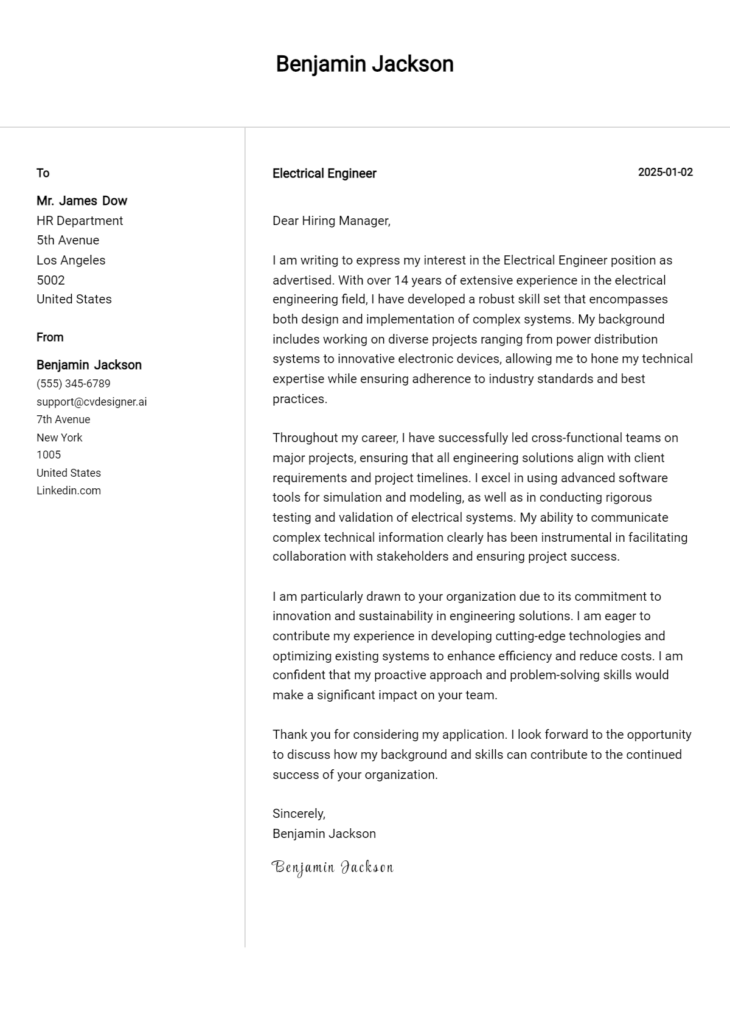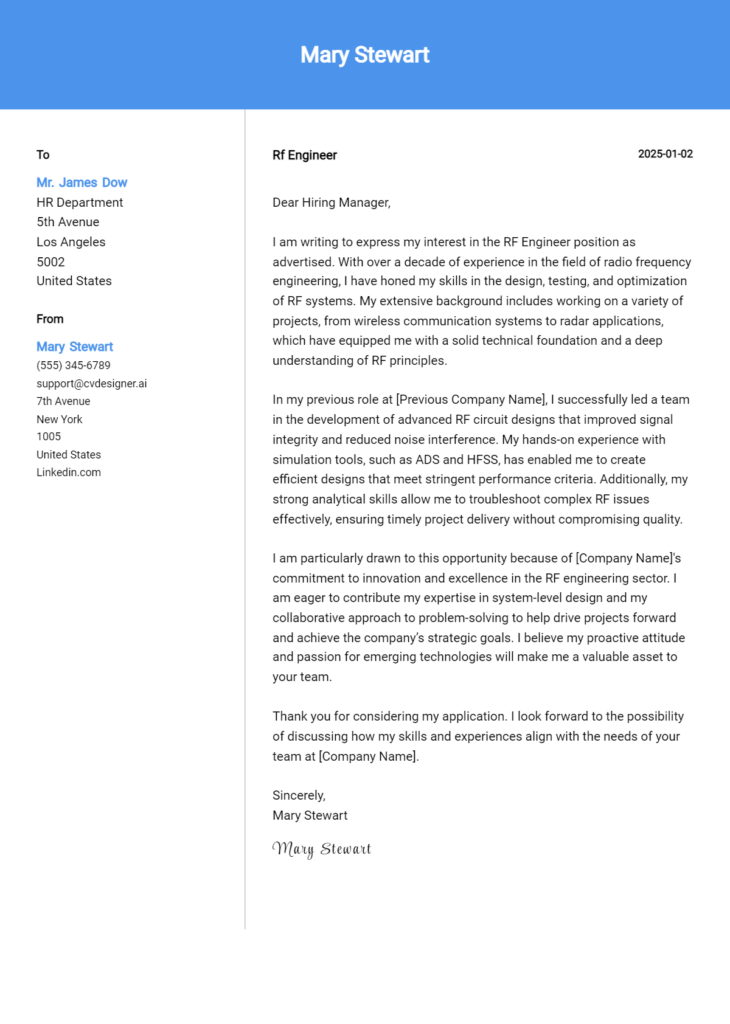Semiconductor Engineer Cover Letter Examples
Explore additional Semiconductor Engineer cover letter samples and guides and see what works for your level of experience or role.
How to Format a Semiconductor Engineer Cover Letter?
Crafting an effective cover letter is crucial for Semiconductor Engineers, as it serves as your first opportunity to demonstrate your technical expertise and problem-solving skills. The way you format your cover letter can significantly influence a hiring manager's perception of your attention to detail and ability to communicate complex ideas clearly. A well-structured cover letter not only emphasizes your qualifications but also reflects the precision and innovation that are essential in the semiconductor industry.
In this guide, we will outline how to format your cover letter, providing specific examples relevant to the semiconductor field to help you create a standout application.
We will focus on the essential components of a professional cover letter, including:
- Cover Letter Header
- Cover Letter Greeting
- Cover Letter Introduction
- Cover Letter Body
- Cover Letter Closing
Each section plays a vital role in showcasing your qualifications and professionalism. Let’s break down each part and explain how to make your Semiconductor Engineer cover letter shine.
Importance of the Cover Letter Header for a Semiconductor Engineer
The cover letter header is a critical component of your job application as a Semiconductor Engineer. It serves as the first impression for potential employers and sets the tone for the rest of your application. A well-organized header should include your contact information, the date, and the recipient's details, ensuring clarity and professionalism. This information not only makes it easy for hiring managers to reach out but also reflects your attention to detail—a crucial skill in the semiconductor field. A strong header can distinguish your application from others, while a weak header may leave a negative impression.
Strong Example
John Doe 1234 Semiconductor Lane Circuit City, CA 90210 johndoe@email.com (123) 456-7890 October 5, 2023 Hiring Manager Tech Innovations Corp. 5678 Chip Avenue Silicon Valley, CA 94016
Weak Example
JD email: johndoe@email.com 5/10/2023 To Whom It May Concern:
The Importance of the Cover Letter Greeting
The greeting of a cover letter is a critical component that sets the tone for the entire document. It establishes a connection with the reader and conveys professionalism from the outset. By directly addressing the hiring manager, you personalize your application and show that you have taken the time to research the company and its leadership. Avoiding generic greetings such as "To Whom It May Concern" demonstrates your commitment to making a meaningful impression. Whenever possible, find the recipient's name through the company's website or LinkedIn profile.
Here are some examples of strong and weak greetings tailored for a Semiconductor Engineer cover letter:
Strong Greeting Example
Dear Dr. Jane Smith,
Weak Greeting Example
To Whom It May Concern,
The Importance of a Strong Cover Letter Introduction for a Semiconductor Engineer
A well-crafted cover letter introduction is crucial for Semiconductor Engineers as it serves as the first impression to hiring managers. This initial paragraph needs to capture attention immediately, express genuine interest in the role, and briefly highlight key skills or achievements that align with the job requirements. A strong introduction not only sets the tone for the rest of the letter but also distinguishes the candidate from others in a competitive field. Below are examples of both effective and ineffective introductions to illustrate the difference.
Strong Example
Dear Hiring Manager, As a passionate Semiconductor Engineer with over five years of hands-on experience in semiconductor device fabrication and a proven track record in optimizing processes for enhanced efficiency, I am excited to apply for the position at [Company Name]. My background in developing innovative solutions that increased yield by 20% in my previous role at [Previous Company] has equipped me with the skills necessary to contribute effectively to your team. I am particularly drawn to this opportunity because of [Company Name]'s commitment to cutting-edge technology and sustainability in semiconductor manufacturing.
Weak Example
To Whom It May Concern, I am writing to apply for the Semiconductor Engineer position. I have a degree in engineering and some experience in the field. I am looking for a job and hope to be considered for this role at [Company Name].
Cover Letter Body for Semiconductor Engineer
The body of a cover letter for a Semiconductor Engineer serves as a critical opportunity for candidates to articulate their relevant skills, experiences, and the unique value they bring to a potential employer. It is essential to highlight specific projects or accomplishments that demonstrate technical expertise, problem-solving abilities, and a commitment to innovation in the semiconductor field. By providing concrete examples of past work, such as successful integration of new manufacturing processes or contributions to cutting-edge research, candidates can effectively illustrate their qualifications and how they align with the company's goals.
Strong Example
Dear Hiring Manager, I am excited to apply for the Semiconductor Engineer position at ABC Technologies. With over five years of experience in semiconductor design and fabrication, I successfully led a project that reduced the manufacturing cycle time by 30% through the implementation of a new photolithography technique. Additionally, I collaborated with a cross-functional team to develop a novel process that improved yield rates by 15%, significantly enhancing overall production efficiency. My hands-on experience with CAD tools and my strong understanding of semiconductor physics allow me to contribute effectively to your team and drive innovative solutions at ABC Technologies. Sincerely, [Your Name]
Weak Example
Dear Hiring Manager, I am interested in the Semiconductor Engineer position at ABC Technologies. I have worked in the semiconductor field for a few years, and I believe I can be a good fit for the role. I have done some projects related to semiconductor manufacturing, but I don't remember the specifics. I am eager to learn more and contribute to your company in any way I can. I think working at ABC Technologies would be a great opportunity for me. Best regards, [Your Name]
Importance of the Cover Letter Closing for a Semiconductor Engineer
The closing of a cover letter is crucial as it leaves a lasting impression on the hiring manager. For a Semiconductor Engineer, it should effectively summarize your qualifications, reiterate your enthusiasm for the role, and encourage the hiring manager to take the next steps, such as reviewing your resume or scheduling an interview. A strong closing can help reinforce your fit for the position and demonstrate your proactive approach, while a weak closing may leave the hiring manager uncertain about your intentions or qualifications.
Strong Example
Thank you for considering my application for the Semiconductor Engineer position at [Company Name]. With a solid background in semiconductor design and fabrication, along with my passion for innovation in the field, I am excited about the opportunity to contribute to your team. I am eager to discuss how my skills align with your needs and would appreciate the chance to further explore this role in an interview. I look forward to the possibility of working together to advance [Company Name]'s mission. Please find my resume attached for your review.
Weak Example
Thanks for reading my letter. I hope you think about my application. I have some experience in semiconductors, and I guess I could be a good fit. Let me know if you want to talk more. I attached my resume, I think.
Crafting an effective cover letter is crucial for Semiconductor Engineer candidates to stand out in a competitive job market. A well-written cover letter not only introduces your qualifications but also offers a platform to showcase your technical skills, problem-solving abilities, knowledge of the Software Development Life Cycle (SDLC), teamwork experience, and passion for continuous learning. Here are some tips to help you create a compelling cover letter that resonates with hiring managers.
Tips for Writing an Effective Cover Letter
Highlight Technical Skills
Clearly outline your technical expertise relevant to semiconductor engineering, such as proficiency in circuit design, simulation software, or fabrication processes. Use specific examples to illustrate how these skills have contributed to project successes in your past roles.Demonstrate Problem-Solving Abilities
Provide concrete examples of challenges you’ve faced in previous projects and how you approached and resolved them. This will showcase your analytical thinking and ability to innovate, which are critical in the semiconductor field.Showcase Your Knowledge of SDLC
If you have experience with the Software Development Life Cycle, discuss your familiarity with its phases and how you have applied this knowledge in your projects. Highlight any specific methodologies you’ve used, such as Agile or Waterfall, to demonstrate your versatility and adaptability.Emphasize Teamwork and Collaboration
Semiconductor engineering often requires collaboration with cross-functional teams. Share experiences where you successfully worked with others to achieve common goals. This will illustrate your ability to contribute to a team environment and your communication skills.Express a Passion for Continuous Learning
The semiconductor industry is rapidly evolving, and showing your commitment to ongoing education and professional development is essential. Mention any relevant certifications, courses, or workshops you have completed, and express your eagerness to stay updated with the latest technologies and trends.
By integrating these tips into your cover letter, you can effectively convey your qualifications and enthusiasm for a Semiconductor Engineer role. For further assistance, consider exploring cover letter templates or using a cover letter builder to refine your approach.
Common Mistakes to Avoid in a Semiconductor Engineer Cover Letter
Avoiding common mistakes in a cover letter is crucial for standing out in the competitive field of semiconductor engineering. A well-crafted cover letter can significantly enhance your chances of landing an interview, while mistakes can undermine your qualifications and intentions. Here are some common pitfalls to be aware of:
Generic Content: Using a one-size-fits-all approach can be detrimental. Tailor your cover letter to the specific job and company by mentioning relevant projects or technologies.
Neglecting Formatting: A poorly formatted cover letter can detract from your professionalism. Ensure you follow a clear cover letter format to maintain readability and structure.
Lack of Specific Examples: Failing to provide concrete examples of your achievements can weaken your application. Highlight specific projects where you made an impact in semiconductor design or fabrication.
Overly Technical Language: While technical expertise is important, using overly complex jargon can alienate hiring managers. Aim for clarity and ensure your accomplishments are understandable to a broader audience.
Ignoring the Employer’s Needs: Make sure to address how your skills align with the company’s goals. Research the company beforehand and tailor your letter to reflect their needs and values.
Typos and Errors: Even minor mistakes can create a negative impression. Proofread your cover letter multiple times and consider using tools to catch grammar and spelling errors.
Failure to Include a Call to Action: Conclude your letter with a clear call to action, expressing your eagerness for an interview and how you plan to follow up.
By steering clear of these mistakes and leveraging cover letter examples for inspiration, you can create a compelling narrative that showcases your qualifications as a semiconductor engineer.
Cover Letter FAQs for Semiconductor Engineer
What should I include in my cover letter as a Semiconductor Engineer?
In your cover letter, you should include a brief introduction stating the position you are applying for and how you found out about it. Highlight your relevant skills and experiences in semiconductor design, fabrication, or testing. Mention specific projects where you contributed to advancements in semiconductor technology, such as improved yield or efficiency. Tailor your cover letter to showcase your proficiency in software tools like CAD or simulation software, and your understanding of industry standards. Also, express your enthusiasm for the company's mission and how your background aligns with their goals. Lastly, conclude with a call to action, inviting them to discuss your application further.
How can I showcase my technical skills effectively?
To effectively showcase your technical skills in your cover letter, focus on quantifiable achievements. Instead of merely stating your skills, describe specific instances where you applied them successfully. For example, mention a project where you utilized specific semiconductor simulation tools to solve a complex problem, and detail the outcome, such as reduced processing time by 20%. Use industry-specific terminology to demonstrate your familiarity with semiconductor engineering concepts, such as VLSI design, DFM (Design for Manufacturability), or IC (Integrated Circuit) fabrication techniques. Additionally, consider including certifications or training that highlight your expertise in relevant technologies. This demonstrates your commitment to professional development and positions you as a knowledgeable candidate.
Should I address the cover letter to a specific person?
Yes, addressing your cover letter to a specific person can make a significant difference. When you find out the name of the hiring manager or recruiter, it personalizes your application and shows your initiative in researching the company. It also establishes a connection and can make your application stand out from others that use generic greetings. If the job posting does not specify a name, consider checking the company's website or LinkedIn for appropriate contacts. If all else fails, "Dear Hiring Manager" is acceptable, but a specific name is always preferable to create a more engaging introduction.
How long should my cover letter be?
Your cover letter should ideally be one page long, consisting of three to four paragraphs. Aim for around 300-400 words, ensuring you are concise while effectively conveying your qualifications and enthusiasm for the position. Start with a strong introduction, followed by a body that highlights your relevant experiences and skills, and finish with a compelling conclusion that reiterates your interest in the role. Avoid overly technical jargon unless necessary, and focus on clarity and readability. A brief, focused cover letter is more likely to be read thoroughly, increasing your chances of making a positive impression.
Build your Cover Letter in minutes
Use an AI-powered cover letter builder and have your letter done in 5 minutes. Just select your template and our software will guide you through the process.

